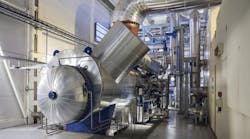A client recently queried me about the installation and operation of a new insertion vortex-shedding flowmeter. The flow measurements were suspect because they were approximately half of the flowrate expected by the plant. We briefly discussed the installation and application where the flowmeter was specified for a liquid with an operating-specific gravity, temperature, and viscosity of 1.2, 110 C, and 140 cSt respectively in a 14-inch line.
Investigation revealed that the actual line size was 16 inches. This change alone would increase the flow measurement by approximately (16/14)² or 30 percent. A more rigorous calculation could be performed using the actual internal diameters of the pipes. However, this cursory result shows that only part of the incorrect measurement could be attributed to configuration of the incorrect pipe size.
This particular vortex-shedding flowmeter has software that filters the signal so as to process signals that are within a frequency band and amplitude band where the measurement would be expected to be located – whereby other signals at other frequencies and/or amplitudes would be considered to be noise. In other words, the flowmeter attempts to lock onto the legitimate flow signal to achieve accurate measurement and reduce the effects of noise.
After some investigation, the vortex-shedding flowmeter was found to be configured using the properties of water. Therefore, due to the large difference between the properties of water as compared to the actual liquid, the vortex-shedding flowmeter was likely filtering in such a manner as to track a part of the signal that did not correspond to the actual flow measurement – thereby causing flow measurement errors.
The configuration was changed to reflect the actual process liquid and the proper line size, after which the vortex-shedder measurement approximately agreed with the expected flow measurement.
Problem solved? Check in next month for further elaboration on this application.
David W. Spitzer is a regular contributor to Flow Control with more than 35 years of experience in specifying, building, installing, startup, troubleshooting and teaching process control instrumentation. Mr. Spitzer has written over 10 books and 150 technical articles about instrumentation and process control, including the popular “Consumer Guide” series that compares flowmeters by supplier. Mr. Spitzer is a principal in Spitzer and Boyes LLC, offering engineering, expert witness, development, marketing, and distribution consulting for manufacturing and automation companies. He can be reached at 845 623-1830.



